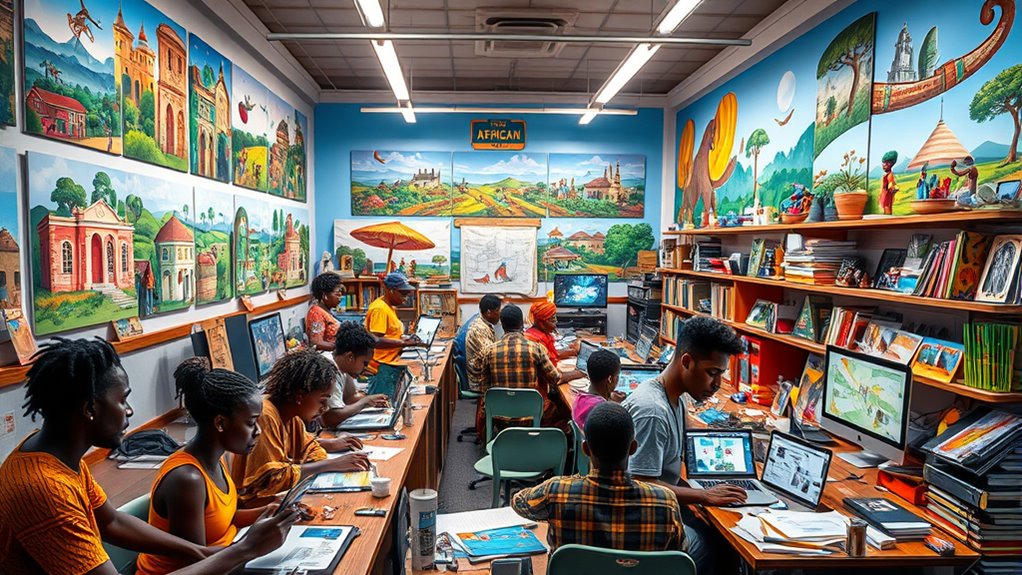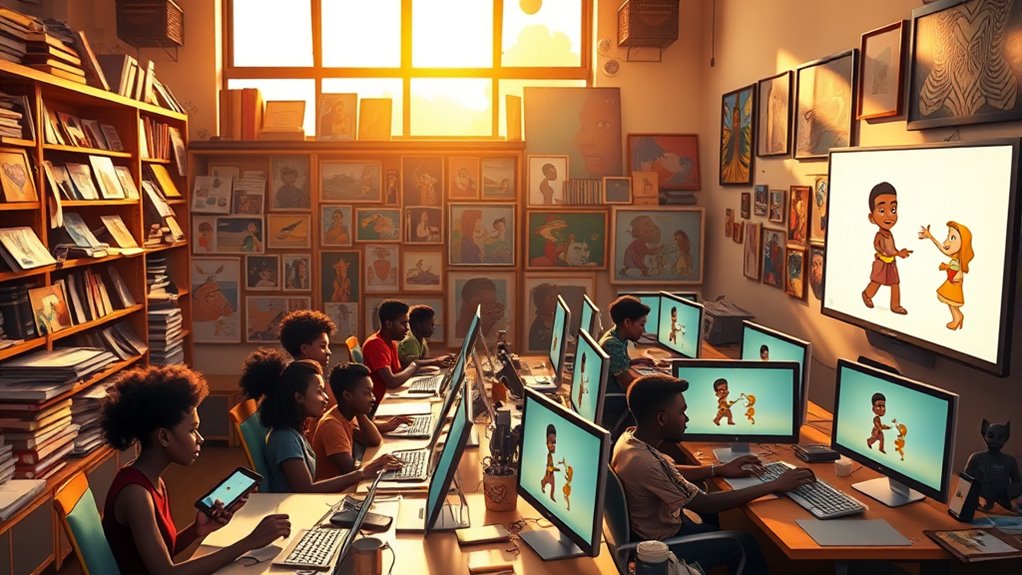African animation studios are growing rapidly, turning the continent into a hub for creative storytelling and innovation. Increased recognition locally and internationally fuels their expansion. Regional collaborations help share resources, skills, and ideas, boosting content quality and market reach. Advances in affordable technology, supportive government initiatives, and a desire to showcase local stories drive this progress. Keep exploring to discover how these developments are shaping the future of African animation worldwide.
Key Takeaways
- African animation studios have experienced significant growth driven by technological advancements and increased industry recognition.
- Regional collaborations enhance resource sharing, skill development, and access to international markets.
- Rising production quality attracts global audiences and investors, elevating Africa’s reputation in animation.
- Industry growth is supported by government initiatives, affordable technology, and storytelling rooted in local cultures.
- Collaborations foster a vibrant creative community, promoting diverse narratives and sustainable industry development.

Over the past few years, African animation studios have experienced remarkable growth, transforming the continent into a vibrant hub for creative storytelling. This surge isn’t just a matter of increased production; it reflects a deeper shift in the animation industry across Africa. You can see how studios are gaining recognition both locally and internationally, thanks to innovative storytelling, improved technology, and a new generation of talented animators. As the industry expands, regional collaborations are playing a essential role. These partnerships help studios share resources, skills, and ideas, which accelerates development and elevates the quality of African animated content. Furthermore, the rise in vetted production quality indicates a rising standard that attracts global audiences and investors alike.
When you look at how these collaborations work, you’ll notice they often involve multiple countries working together on projects that showcase diverse cultural narratives. This pooling of talent and expertise means studios can produce higher-quality animations without the massive costs traditionally associated with animation production. It also creates opportunities for knowledge exchange, training, and mentorship, which are indispensable for nurturing local talent. These regional ties help studios tap into new markets, attract funding, and access international distribution channels. As a result, African animation isn’t just growing in volume but also in sophistication and appeal.
The growth of the animation industry in Africa is driven by a combination of factors, including increasing access to affordable technology, government initiatives, and the desire to tell stories rooted in local traditions and contemporary issues. You’ll find that many studios are now experimenting with different styles, blending traditional art forms with modern animation techniques. This innovation attracts audiences both within Africa and across the globe, highlighting the continent’s rich cultural diversity. Regional collaborations further amplify this impact by allowing studios to pool their strengths and reach wider audiences more effectively.
Moreover, these collaborations foster a sense of community among African creators. You’ll see artists from different countries working together on projects that celebrate shared histories and unique perspectives. This camaraderie enhances the industry’s sustainability and encourages a new wave of storytellers eager to push boundaries. As the animation industry continues to evolve, regional partnerships will remain a key driver in fostering creativity, increasing production capacity, and opening doors to international markets. The future of African animation looks promising, powered by collaborative efforts that strengthen the industry’s foundation and showcase Africa’s vibrant cultural landscape to the world.
Frequently Asked Questions
What Are the Biggest Challenges Faced by African Animation Studios?
You face significant challenges like distribution hurdles, which make it hard to get your animations to a wider audience. Talent retention is also tough, as skilled artists often look elsewhere for better opportunities. Limited funding and infrastructure further hinder your progress. Overcoming these issues requires innovative solutions, stronger industry networks, and support to keep talented creators engaged and guarantee your work reaches global markets.
How Do African Animation Styles Differ From Global Trends?
You wonder how African animation styles differ from global trends? It’s all about regional storytelling and unique artistic influences. While international styles often follow mainstream aesthetics, African animations infuse local culture, folklore, and vibrant visuals that tell a story only you can experience. These regional influences create a distinctive rhythm and authenticity, making African animation stand out in a crowded global scene, capturing hearts with stories rooted in tradition and modern creativity.
What Funding Sources Are Available for New African Animation Startups?
You can find funding for your African animation startup through venture capital firms that focus on creative industries and innovation. Additionally, government grants are available, often aimed at promoting local arts and technology. Networking with industry associations and pitching your ideas to investors can also open doors. Keep an eye on international development programs that support African entrepreneurs, as they frequently offer financial aid tailored to creative startups like yours.
How Is Local Culture Integrated Into African Animated Content?
You can see local culture in African animated content through cultural storytelling, which highlights unique traditions and histories. Incorporating traditional art forms like beadwork, textiles, and dance enriches the visuals and narrative. By blending these elements, creators preserve cultural identity while making stories relatable. This approach not only educates audiences about diverse customs but also celebrates African heritage, making the content authentic and vibrant.
What Impact Has Digital Technology Had on African Animation Production?
They say, “The pen is mightier than the sword,” and digital technology proves this true in African animation. You harness digital innovation and advanced animation software to produce higher-quality content faster and more cost-effectively. This shift empowers creators to experiment, tell authentic stories, and reach wider audiences. As a result, African animation gains visibility, fostering cultural pride and opening new opportunities for local storytellers in the global digital landscape.
Conclusion
So, as you watch African animation studios flourish, you might think it’s just about colorful cartoons and entertainment. But in reality, it’s a powerful reminder that Africa’s creative voices are finally getting the global spotlight they deserve. Ironically, what once seemed like small, local stories are now shaping the world’s cultural narrative. Keep an eye on these studios—they’re not just making animations, they’re redefining storytelling itself.








